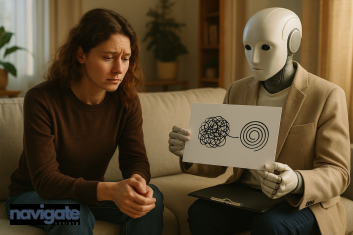Demystifying CBT: How Psychoeducation Builds Trust, Clarity, and Motivation (part 4 of our Gold Standard series)
Posted on: Apr 11, 2025
When someone begins therapy for anxiety, they often carry a heavy burden: confusion, self-blame, and fear that their symptoms are beyond control. That’s why one of the most important early goals in Cognitive Behavioural Therapy (CBT) is to provide clarity. This is where psychoeducation comes in—and it can be a game-changer.
What Is Psychoeducation?
Psychoeducation is the process of helping clients understand:
- What anxiety is from a biological, psychological, and behavioural standpoint
- How CBT works
- What the treatment roadmap looks like
- Why their symptoms make sense, even if they feel overwhelming
It’s not about simplifying complex experiences—it’s about organising them in a way that gives clients agency and self-compassion.
Normalising the Experience of Anxiety
Psychoeducation helps people realise:
- Anxiety is a biological response to perceived threat
- It’s often not dangerous, just uncomfortable
- Avoidance and safety behaviors, while understandable, maintain anxiety in the long run
- Therapy doesn't eliminate anxiety—it changes our relationship to it
This normalisation process reduces shame. It also builds motivation: "If this is a known process, maybe there’s a known path to feeling better."
Explaining the CBT Model: A Clear, Evidence-Based Framework
CBT uses a simple but powerful model: our thoughts influence our feelings and behaviors. During psychoeducation, clients learn to:
- Identify negative automatic thoughts ("I’m going to fail")
- Understand how these thoughts affect emotions (anxiety, dread)
- See how behaviours (avoidance, overpreparation) reinforce the cycle
This clarity is often empowering. Clients start noticing patterns in real-time, even before they've begun formal interventions like thought records or exposure exercises.
Setting the Stage for Active Participation
Many clients come to therapy expecting to vent or talk about their past. While those elements can be helpful, CBT is more structured. Psychoeducation prepares them for:
- Weekly homework assignments
- Self-monitoring of anxiety levels and thoughts
- Gradual behavioural experiments (e.g., exposures)
- A collaborative, problem-solving approach
By understanding this upfront, clients are more likely to engage fully and stick with the process.
Conclusion: Education as Empowerment
Psychoeducation is the bridge between uncertainty and action. When clients understand how anxiety works and how therapy will address it, they shift from feeling powerless to feeling prepared. This mindset doesn’t just make therapy more effective—it lays the emotional and intellectual groundwork for meaningful, lasting change. In the world of CBT, knowledge isn’t just power. It’s healing.




